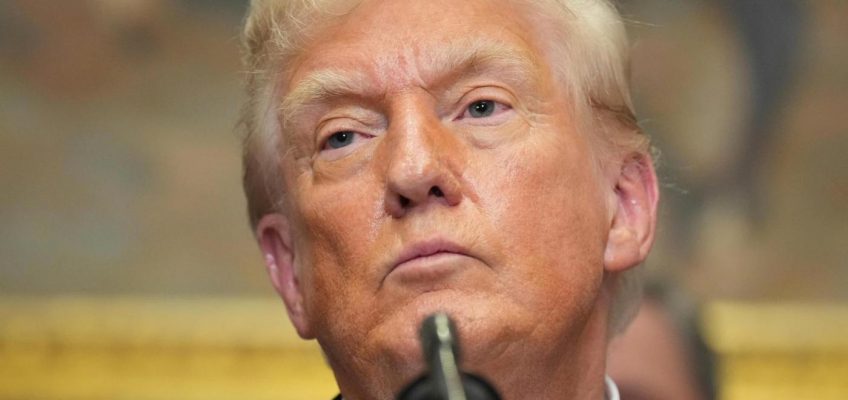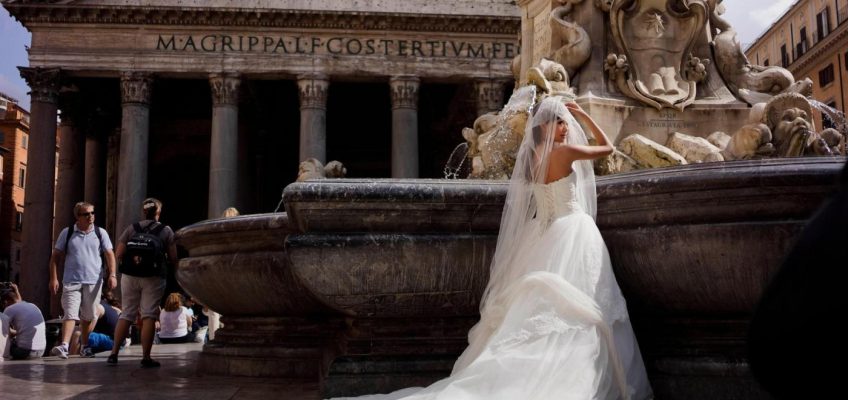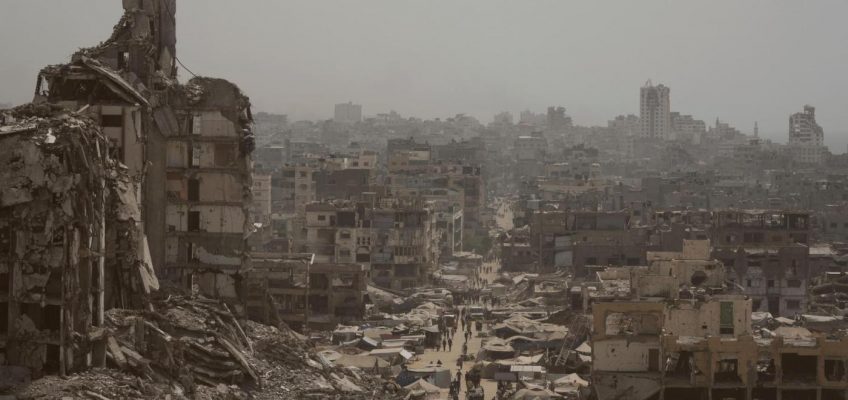Post Content
Trump orders US nuclear subs repositioned over statements from ex-Russian leader Medvedev
By WILL WEISSERT, Associated Press
WASHINGTON (AP) — In a warning to Russia, President Donald Trump said Friday he’s ordering the repositioning of two U.S. nuclear submarines “based on the highly provocative statements” of the country’s former president Dmitry Medvedev.
Trump posted on his social media site that based on the “highly provocative statements” from Medvedev he had “ordered two Nuclear Submarines to be positioned in the appropriate regions, just in case these foolish and inflammatory statements are more than just that.”
The president added, “Words are very important, and can often lead to unintended consequences, I hope this will not be one of those instances.”
It wasn’t immediately clear what impact Trump’s order would have on U.S. nuclear subs, which are routinely on patrol in the world’s hotspots, but it comes at a delicate moment in the Trump administration’s relations with Moscow.
Trump has said that special envoy Steve Witkoff is heading to Russia to push Moscow to agree to a ceasefire in its war with Ukraine and has threatened new economic sanctions if progress is not made. He cut his 50-day deadline for action to 10 days, with that window set to expire next week.
The post about the sub repositioning came after Trump, in the wee hours of Thursday morning, had posted that Medvedev was a “failed former President of Russia” and warned him to “watch his words.” Medvedev responded hours later by writing, “Russia is right on everything and will continue to go its own way.”
Medvedev was president from 2008 to 2012 while Putin was barred from seeking a second consecutive term but stepped aside to let him run again. Now deputy chairman of Russia’s National Security Council, which Putin chairs, Medvedev has been known for his provocative and inflammatory statements since the start of the war in 2022, a U-turn from his presidency, when he was seen as liberal and progressive.
He has frequently wielded nuclear threats and lobbed insults at Western leaders on social media. Some observers have argued that with his extravagant rhetoric, Medvedev is seeking to score political points with Putin and Russian military hawks.
Related Articles
NASA, SpaceX punch through weather threat for Crew-11 launch
Teacher charged in fatal stabbings in Arkansas bounced between schools in 3 states
Prosecutors seek substantial prison term for Sean ‘Diddy’ Combs as they oppose bail
Wall Street slumps and bond yields sink following weak hiring numbers and new tariffs
Google loses appeal in antitrust battle with Fortnite maker
Trump and Medvedev have gotten into online spats before.
On July 15, after Trump announced plans to supply Ukraine with more weapons via its NATO allies and threatened additional tariffs against Moscow, Medvedev posted, “Trump issued a theatrical ultimatum to the Kremlin. The world shuddered, expecting the consequences. Belligerent Europe was disappointed. Russia didn’t care.”
Earlier this week, he wrote, “Trump’s playing the ultimatum game with Russia: 50 days or 10″ and added, “He should remember 2 things: 1. Russia isn’t Israel or even Iran. 2. Each new ultimatum is a threat and a step towards war. Not between Russia and Ukraine, but with his own country.”
Associated Press writer Dasha Litvinova in Tallinn, Estonia, contributed to this report.
More American couples are turning to Italy’s ‘dolce vita’ in a quest for memorable weddings
By DARIO ARTALE and DAVID BILLER
FLORENCE, Italy (AP) — James Atkinson and Samantha Fortino toured a Tuscan vineyard and learned to make pasta and a Bolognese sauce alongside their family and friends in Florence. Atkinson discovered a penchant for chianti, while Fortino fell for Italy’s hugo spritz — a cocktail that posed no risk of staining her wedding dress on July 24.
Italy has hosted a number of star-studded weddings in the past decade, most recently Jeff Bezos and Lauren Sánchez ’s extravaganza in Venice. Away from the spotlight, tens of thousands of ordinary Americans have set their sights on the country for their special day in recent years.
“Weddings in America can be a little too grand and a little bit too big and it ends up not really being about the couple,” said Fortino, 28, a neonatal nurse from Skaneateles, New York. “We both just really wanted something intimate and meaningful.”
Over 15,000 foreign couples wed in Italy last year, up 64% from 2019, the year before the pandemic, according to market research from the Center of Tourist Studies of Florence. Growth was led by U.S couples, who account for almost one-third of that total.
Italy was the top international destination for American couples after Mexico, according to Maryland-based wedding planning website The Knot.
For many Americans, Italy embodies the simple, beautiful romance of a bygone era. Weather is balmy and its varied landscapes, from the sea to the mountains, stunning. The food is familiar and crowd-pleasing. But perhaps the biggest driver of the recent uptick is ample opportunity for a range of outings, which together with the wedding event are alluring for those on a quest for unique, memorable moments — part of a consumer trend termed “the experience economy.”
“In the United States, everything is just more expensive for one night and we wanted to make an experience, so we did two nights here,” said Atkinson, 31, who owns a concrete company. “It just seemed like way more worth it to us to do that and make a trip out of it with our family, our loved ones.”
‘Nobody cancels’
One guest who had never visited Italy was ecstatic about the invite, and took advantage to tack on side trips, first to Venice and then with the wedding crew to Cinque Terre. Another, Gary Prochna, nearly didn’t attend because of work piling up at his paving company. He eventually came around and was floored by the venue — a 15th-century villa with a sweeping view over Florence and its famous Duomo.
“I got married in the United States and our venue was very nice. I thought — until this moment — we had the best wedding,” said Prochna, 68, adding that he now hopes his daughters will get hitched abroad.
More than half of Americans surveyed by Mastercard in January 2024 said they prefer to spend their money on memory-making experiences, and more than a third said they’d plan a whole trip around one particular experience.
Related Articles
Kyiv mourns after deadliest attack in a year kills 31 people in Ukraine, including 5 children
Beloved children’s author Allan Ahlberg dies at 87
Why not enough food is reaching people in Gaza even after Israel eased its blockade
Musk, a social media powerhouse, boosts fortunes of hard-right figures in Europe
US envoy visits aid site in Gaza run by Israeli-backed group that has been heavily criticized
Marcy Blum, a prominent luxury event planner based in Manhattan, said almost 90% of the weddings she plans abroad are in Italy.
“The reason Italy is so popular is because that’s where your guests want to go,” she said. “You send an invitation that you’re getting married in Capri or Positano and everybody comes. Everybody. They want to come. Nobody cancels.”
Jack Ezon, CEO of Embark Beyond, a luxury travel and destination event service also based in Manhattan, said 60% of his company’s events were outside the U.S. before the pandemic. Today it’s almost 90%, nearly all split evenly between Italy and France.
The threat of tariffs under President Donald Trump has given destination weddings a boost. Ezon has moved six events from the U.S. to Europe this year, because people were afraid tariffs on alcohol would cause their bar bill to explode.
Cost comparison
The shift to destinations has benefited planners with networks across Italy and local vendors. According to Wedding Italy, the husband-and-wife team who put on the Atkinson wedding, American clients spend three times as much as Italians, due to more elaborate wedding decor and other events in their multiday lineup.
Average spend on hometown weddings in the U.S. was $32,000 last year, according to The Knot. By comparison, foreigners’ weddings in Italy cost an average 61,500 euros ($70,600) and typically have dozens fewer guests, the Center of Tourist Studies of Florence’s data showed.
In the garden where the Atkinsons held their service, cypress trees swayed in the wind as the bride emerged from the chapel, beaming in her lace mermaid-silhouette gown. She walked down the aisle as speakers played the theme song to Star Wars. It was her sneaky trick to make the groom cry, and it worked like a charm.
Before the exchange of rings, before the lovebirds threw their arms around one another, their officiant said:
“Traditionally I would ask: Is there any reason why this couple shouldn’t be married? But for goodness’ sake – we all flew to Italy and can’t get our points back! So instead I’ll ask: Who here approves of this union?”
Cheers all around.
Western countries speak of a future Palestinian state as the nightmare unfolding in Gaza worsens
By JOSEPH KRAUSS, Associated Press
OTTAWA, Ontario (AP) — Plans announced by France, the United Kingdom and Canada to recognize a Palestinian state won’t bring one about anytime soon, though they could further isolate Israel and strengthen the Palestinians’ negotiating position over the long term.
The problem for the Palestinians is that there may not be a long term.
Israeli Prime Minister Benjamin Netanyahu rejects Palestinian statehood and has vowed to maintain open-ended control over annexed east Jerusalem, the occupied West Bank and the war-ravaged Gaza Strip — territories Israel seized in the 1967 war that the Palestinians want for their state.
Israeli leaders favor the outright annexation of much of the West Bank, where Israel has already built well over 100 settlements housing over 500,000 Jewish settlers. Israel’s offensive in Gaza has reduced most of it to a smoldering wasteland and is pushing it toward famine, and Israel says it is pressing ahead with plans to relocate much of its population of some 2 million to other countries.
The United States, the only country with any real leverage over Israel, has taken its side.
Palestinian Prime Minister Mohammed Mustafa speaks during a high-level International Conference for the Peaceful Settlement of the Question of Palestine and the Implementation of the Two-State solution at United Nations Headquarters, on Monday, July 28, 2025 .(AP Photo/Adam Gray)
Critics say these countries could do much more
Palestinians have welcomed international support for their decades-long quest for statehood but say there are more urgent measures Western countries could take if they wanted to pressure Israel.
“It’s a bit odd that the response to daily atrocities in Gaza, including what is by all accounts deliberate starvation, is to recognize a theoretical Palestinian state that may never actually come into being,” said Khaled Elgindy, a visiting scholar at Georgetown University’s Center for Contemporary Arab Studies.
“It looks more like a way for these countries to appear to be doing something,” he said.
Fathi Nimer, a policy fellow at Al-Shabaka, a Palestinian think tank, says they could have suspended trade agreements with Israel, imposed arms embargoes or other sanctions. “There is a wide tool set at the disposal of these countries, but there is no political will to use it,” he said.
A resident inspects a torched vehicle following a spree of violent rampage by Israeli settlers overnight that left one dead Palestinian American, a burnt house and several torched vehicles in three Palestinian towns, in the West Bank town of Rammun, east of Ramallah Thursday, July 31, 2025. (AP Photo/Nasser Nasser)
It’s not a completely empty gesture
Most countries in the world recognized Palestinian statehood decades ago, but Britain and France would be the third and fourth permanent members of the U.N. Security Council to do so, leaving the U.S. as the only holdout.
“We’re talking about major countries and major Israeli allies,” said Alon Pinkas, an Israeli political analyst and former consul general in New York. “They’re isolating the U.S. and they’re leaving Israel dependent — not on the U.S., but on the whims and erratic behavior of one person, Trump.”
Related Articles
Why not enough food is reaching people in Gaza even after Israel eased its blockade
US envoy visits aid site in Gaza run by Israeli-backed group that has been heavily criticized
With growing urgency, more US Jews urge Israel to ensure ample food deliveries to Gaza
US envoy arrives in Israel to monitor Gaza food distribution as humanitarian crisis worsens
Trump seeks to use Canada’s recognition of Palestinian state as leverage in trade talks
Recognition could also strengthen moves to prevent annexation, said Hugh Lovatt, an expert on the conflict at the European Council on Foreign Relations. The challenge, he said, “is for those recognizing countries to match their recognition with other steps, practical steps.”
It could also prove significant if Israel and the Palestinians ever resume the long-dormant peace process, which ground to a halt after Prime Minister Benjamin Netanyahu returned to office in 2009.
“If and when some kind of negotiations do resume, probably not in the immediate future, but at some point, it puts Palestine on much more equal footing,” said Julie Norman, a professor of Middle East politics at University College London.
“It has statehood as a starting point for those negotiations, rather than a certainly-not-assured endpoint.”
Israel calls it a reward for violence
Israel’s government and most of its political class were opposed to Palestinian statehood long before Hamas’ Oct. 7, 2023, attack triggered the war. Hamas has been designated as a terrorist organization by the United States, Canada and the European Union.
Netanyahu says creating a Palestinian state would reward Hamas and eventually lead to an even larger Hamas-run state on Israel’s borders. Hamas leaders have at times suggested they would accept a state on the 1967 borders but the group remains formally committed to Israel’s destruction.
Western countries envision a future Palestinian state that would be democratic but also led by political rivals of Hamas who accept Israel and help it suppress the group, which won parliamentary elections in 2006 and seized power in Gaza the following year.
Palestinian President Mahmoud Abbas, whose authority administers parts of the occupied West Bank, supports a two-state solution and cooperates with Israel on security matters. He has made a series of concessions in recent months, including announcing the end to the Palestinian Authority’s practice of providing stipends to the families of prisoners held by Israel and slain combatants.
Such measures, along with the security coordination, have made it deeply unpopular with Palestinians, and have yet to earn it any favors from Israel or the Trump administration. Israel says Abbas is not sincerely committed to peace and accuses him of tolerating incitement and militancy.
Lovatt says there is much to criticize about the PA, but that “often the failings of the Palestinian leadership are exaggerated in a way to relieve Israel of its own obligations.”
Israeli right-wing activists watch the northern Gaza Strip during a rally calling for the re-establishment of Jewish settlements in the Gaza Strip, near the border in southern Israel, Wednesday, July 30, 2025. (AP Photo/Ohad Zwigenberg)
The tide may be turning, but not fast enough
If you had told Palestinians in September 2023 that major countries were on the verge of recognizing a state, that the U.N.’s highest court had ordered Israel to end the occupation, that the International Criminal Court had ordered Netanyahu’s arrest, and that prominent voices from across the U.S. political spectrum were furious with Israel, they might have thought their dream of statehood was at hand.
But those developments pale in comparison to the ongoing war in Gaza and smaller but similarly destructive military offensives in the West Bank. Israel’s military victories over Iran and its allies have left it the dominant and nearly unchallenged military power in the region, and Trump is the strongest supporter it has ever had in the White House.
“This (Israeli) government is not going to change policy,” Pinkas said. “The recognition issue, the ending of the war, humanitarian aid — that’s all going to have to wait for another government.”
Associated Press writer Jill Lawless in London contributed.



